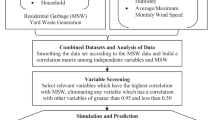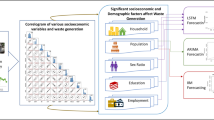Abstract
In the developing countries, the inadequacy of basic waste data is a significant obstacle for municipal solid waste management. To evaluate an effective waste management plan, identification of influencing socio-economic factors and projection of municipal solid waste generation (MSWG) plays a crucial role. Yet, several forecasting methods have been utilized to quantify future MSWG. In this study, we investigated the influencing socio-economic factors for MSWG in China using the fuzzy logic method, and a short-term forecasting of MSWG was conducted using multi-model approach. The Grey (1, 1), linear regression, and artificial neural network (ANN) models were evaluated for short-term forecasting. The factor analysis results show that urban population growth is the most influencing socio-economic factor for MSWG, and the influence of GDP on waste generation is not so obvious. Afterward, the multi-model forecasting results indicate an increasing trend of MSWG. Based on the absolute percentage error, root mean-squared error, mean absolute error, and coefficient of determination (R2), ANN found as the most acceptable model to forecast MSWG in China. Hence, the forecasting by ANN model illustrates that MSWG in China will be 24666.65 (104 tons) by 2030.




Similar content being viewed by others
References
Mian MM, Zeng X, Nasry A al Bin N, Al-Hamadani SMZF. (2016) Municipal solid waste management in China: a comparative analysis. J Mater Cycles Waste Manag 1–9
Ghinea C, Drăgoi EN, Comăniţă E-D et al (2016) Forecasting municipal solid waste generation using prognostic tools and regression analysis. J Environ Manage 182:80–93
Hoornweg D, Bhada-Tata P (2012) What a waste?: a global review of solid waste management, urban development series knowledge papers no. 15. World Bank, Washington DC, pp 1–98
Oribe-Garcia I, Kamara-Esteban O, Martin C et al (2015) Identification of influencing municipal characteristics regarding household waste generation and their forecasting ability in Biscay. Waste Manag 39:26–34
Sha’Ato R, Aboho SY, Oketunde FO et al (2007) Survey of solid waste generation and composition in a rapidly growing urban area in Central Nigeria. Waste Manag 27:352–358
Tonjes DJ, Greene KL (2012) A review of national municipal solid waste generation assessments in the USA. Waste Manag Res 30:758–771
Duan H, Hu J, Tan Q et al (2016) Systematic characterization of generation and management of e-waste in China. Environ Sci Pollut Res 23:1929–1943
Katsamaki A, Willems S, Diamadopoulos E (1998) Time series analysis of municipal solid waste generation rates. J Environ Eng 124:178–183
Xu L, Gao P, Cui S, Liu C (2013) A hybrid procedure for MSW generation forecasting at multiple time scales in Xiamen City, China. Waste Manag 33:1324–1331
Navarro-Esbrí J, Diamadopoulos E, Ginestar D (2002) Time series analysis and forecasting techniques for municipal solid waste management. Resour Conserv Recycl 35:201–214
Antanasijević D, Pocajt V, Popović I et al (2013) The forecasting of municipal waste generation using artificial neural networks and sustainability indicators. Sustain Sci 8:37–46
Ali Abdoli M, Falah Nezhad M, Salehi Sede R, Behboudian S (2012) Longterm forecasting of solid waste generation by the artificial neural networks. Environ Prog Sustain Energy 31:628–636
Kolekar KA, Hazra T, Chakrabarty SN (2016) A review on prediction of municipal solid waste generation models. Procedia Environ Sci 35:238–244
Abbasi M, Abduli MA, Omidvar B, Baghvand A (2012) Forecasting municipal solid waste generation by hybrid support vector machine and partial least square model. Int J Environ Res 7:27–38
Chung SS (2010) Projecting municipal solid waste: the case of Hong Kong SAR. Resour Conserv Recycl 54:759–768
Makridakis S, Wheelwright SC, Hyndman RJ (2008) Forecasting methods and applications. Wiley, Oxford
Pai TY, Chiou RJ, Wen HH (2008) Evaluating impact level of different factors in environmental impact assessment for incinerator plants using GM (1, N) model. Waste Manag 28:1915–1922
Tien T-L (2012) A research on the grey prediction model GM(1,n). Appl Math Comput 218:4903–4916
Kayacan E, Ulutas B, Kaynak O (2010) Grey system theory-based models in time series prediction. Expert Syst Appl 37:1784–1789
Abbasi M, El Hanandeh A (2016) Forecasting municipal solid waste generation using artificial intelligence modelling approaches. Waste Manag 56:13–22
Liu G, Yu J (2007) Gray correlation analysis and prediction models of living refuse generation in Shanghai city. Waste Manag 27:345–351
Ying L, Weiran L, Jingyi L (2011) Forecast the output of municipal solid waste in Beijing satellite towns by combination models. 2011 Int Conf Electr Technol Civ Eng 1269–1272
Russell SJ, Norvig P (1995) Artificial intelligence, a modern approach. Alan Apt, Prentice Hall, Englewood Cliffs, p 07632
Agatonovic-Kustrin S, Beresford R (2000) Basic concepts of artificial neural network (ANN) modeling and its application in pharmaceutical research. J Pharm Biomed Anal 22:717–727
Noori R, Abdulreza K, Mohammad SS (2010) Evaluation of PCA and gamma test techniques on ANN operation for weekly solid waste prediction. J Environ Manage 91:767–771
Abbasi M, Abduli MA, Omidvar B, Baghvand A (2013) Results uncertainty of support vector machine and hybrid of wavelet transform-support vector machine models for solid waste generation forecasting. Environ Prog Sustain Energy 33:220–228
Lozano-Olvera G, Ojeda-Benítez S, Castro-Rodríguez JR et al (2008) Identification of waste packaging profiles using fuzzy logic. Resour Conserv Recycl 52:1022–1030
Moreno JE, Castillo O, Castro JR et al (2007) Data mining for extraction of fuzzy IF-THEN rules using Mamdani and Takagi-Sugeno-Kang FIS. Eng Lett 15:82–88
Kawai K, Tasaki T (2016) Revisiting estimates of municipal solid waste generation per capita and their reliability. J Mater Cycles Waste Manag 18:1–13
People’s Congress Law of People’s Republic of China on Circular Economy Promotion. http://www.sepa.gov.cn/law/law/200809/t20080901_128001.htm. Accessed 20 Aug 2017
MOC (2007) Management measure on urban waste. http://www.gov.cn/ziliao/flfg/2007-06/05/content_636413.htm. Accessed 27 Aug 2017
Dijkgraaf E, Gradus RHJM. (2004) Cost savings in unit-based pricing of household waste: the case of The Netherlands. Resour Energy Econ 26:353–371
van Beukering PJH, Bartelings H, Linderhof VGM, Oosterhuis FH (2009) Effectiveness of unit-based pricing of waste in the Netherlands: applying a general equilibrium model. Waste Manag 29:2892–2901
Chu Z, Wu Y, Zhuang J (2017) Municipal household solid waste fee based on an increasing block pricing model in Beijing, China. Waste Manag Res 35:228–235
Havukainen J, Zhan M, Dong J et al (2017) Environmental impact assessment of municipal solid waste management incorporating mechanical treatment of waste and incineration in Hangzhou, China. J Clean Prod 141:453–461
Liu Y, Ni Z, Kong X, Liu J (2017) Greenhouse gas emissions from municipal solid waste with a high organic fraction under different management scenarios. J Clean Prod 147:451–457
Du M, Peng C, Wang X et al (2017) Quantification of methane emissions from municipal solid waste landfills in China during the past decade. Renew Sustain Energy Rev 78:272–279
Hong J, Chen Y, Wang M et al (2017) Intensification of municipal solid waste disposal in China. Renew Sustain Energy Rev 69:168–176
Li X, Zhang C, Li Y, Zhi Q (2016) The status of municipal solid waste incineration (MSWI) in China and its clean development. Energy Procedia 104:498–503
Lu J-W, Zhang S, Hai J, Lei M (2017) Status and perspectives of municipal solid waste incineration in China: a comparison with developed regions. Waste Manag 69:170–186
Wang Y, Cheng K, Wu W et al (2017) Atmospheric emissions of typical toxic heavy metals from open burning of municipal solid waste in China. Atmos Environ 152:6–15
Han Z, Ma H, Shi G et al (2016) A review of groundwater contamination near municipal solid waste landfill sites in China. Sci Total Environ 569–570:1255–1264
Yang N, Damgaard A, Kjeldsen P et al (2015) Quantification of regional leachate variance from municipal solid waste landfills in China. Waste Manag 46:362–372
National Bureau of Statistics of China (Annual Data 2016). http://www.stats.gov.cn/tjsj/ndsj/2016/indexeh.htm
Farzana S, Liu M, Baldwin A, Hossain MU (2014) Multi-model prediction and simulation of residential building energy in urban areas of Chongqing, South West China. Energy Build 81:161–169
Mathworks (2016) What is fuzzy logic? https://www.mathworks.com/help/fuzzy/what-is-fuzzy-logic.html
Tien T-L (2009) A new grey prediction model FGM(1, 1). Math Comput Model 49:1416–1426
Kim S, Kim H (2016) A new metric of absolute percentage error for intermittent demand forecasts. Int J Forecast 32:669–679
Faber N (Klaas) M (1999) Estimating the uncertainty in estimates of root mean square error of prediction: application to determining the size of an adequate test set in multivariate calibration. Chemom Intell Lab Syst 49:79–89
Jöckel K-H, Pflaumer P (1984) Calculating the variance of errors in population forecasting. Stat Probab Lett 2:211–213
Liu C, Wu X (2011) Factors influencing municipal solid waste generation in China: a multiple statistical analysis study. Waste Manag Res 29:371–378
Sokka L, Antikainen R, Kauppi PE (2007) Municipal solid waste production and composition in Finland—changes in the period 1960–2002 and prospects until 2020. Resour Conserv Recycl 50:475–488
Sharholy M, Ahmad K, Mahmood G, Trivedi RC (2008) Municipal solid waste management in Indian cities—a review. Waste Manag 28:459–467
Chiemchaisri C, Juanga JP, Visvanathan C (2007) Municipal solid waste management in Thailand and disposal emission inventory. Environ Monit Assess 135:13–20
Maxwell AE (1975) Limitations on the use of the multiple linear regression model. Br J Math Stat Psychol 28:51–62
Xie N, Liu S (2009) Discrete grey forecasting model and its optimization. Appl Math Model 33:1173–1186
Mian MM, Zeng X, Nasry ANB, Al-Hamadani SMZF (2017) Municipal solid waste management in China: a comparative analysis. J Mater Cycles Waste Manag 19:1127–1135
Zhang DQ, Tan SK, Gersberg RM (2010) Municipal solid waste management in China: status, problems and challenges. J Environ Manage 91:1623–1633
Acknowledgements
We thank the editors and anonymous reviewers for giving us many constructive comments that significantly improved the paper.
Author information
Authors and Affiliations
Corresponding author
Electronic supplementary material
Below is the link to the electronic supplementary material.
Rights and permissions
About this article
Cite this article
Chhay, L., Reyad, M.A.H., Suy, R. et al. Municipal solid waste generation in China: influencing factor analysis and multi-model forecasting. J Mater Cycles Waste Manag 20, 1761–1770 (2018). https://doi.org/10.1007/s10163-018-0743-4
Received:
Accepted:
Published:
Issue Date:
DOI: https://doi.org/10.1007/s10163-018-0743-4




